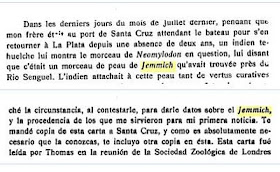
Ameghino on the Jemmich. Copyright © 2007 by Austin Whittall. From [1]
Florentino Amehgino was the first scientist to mention as a fact, that there were surviving megafunal mylodons alive in Patagonia in the late 1890s. In a letter, he wrote [1]:
In the last days of the month of July of 1898, while me brother waited at Santa Cruz Port for the steamer that would bring him back to La Plata after an absence of two years, a Tehuelche Indian came up to him to show him a piece of the Neomylodon in question, telling him that it was a piece of Jemmich hide, that he had found close to the Senguel River [now known as Senguer]. The Indian gave thie hide medicinal properties and did not want to let it go at any price and only with great difficulty did he let him get some tiny dermal boness [from it]
[...]
Jemmich the name that the Tehuelche Indians give this animal that they know well but whose story has always been taken as a fable (legend). For some time now, my brother hears them talk about Jemmich as a fierce animal, with large claws, defenses and a prehensile tail, strong enough to capture horses and tear them apart with claws, defenses and tail at the same time.
About two years ago, an Indian named Hopen, with whom my brother had acquaintance told him that close to the River Senguel, going from Chubut to Santa Cruz, he came across a Jemmich that he had to confront and which he managed to kill. This Indian wanted to take my brother to the place where the corpse was, but he, incredulous, did not believe him.
From the information that all the Tehuelche Indians give, the Jemmich (or Neomylodon lives in sheltered areas by the shores of the lakes Colihue [sic : Colhue], Fontana, General Paz, Gio, Buenos Aires and the rivers Senguel, Aysen, Huemules, etc.
It is of nocturnal habits and rarely goes out during the day and it moves about the ground with the same ease that it swims in the water. Its skull is short with large fangs, rudimentary external ears, short legs, plantigrade feet with four toes on the front [paws] and three on the rear [ones], linked by a natatory membrane and endowed with nails or excessively long claws (which seems at odds with the presence of natatory membranes). The tail is thick, long, flattened, hairy and very prehensile. Its size, according to the Indians, is comparable to that of a large puma, but with a slightly longer body and with shorter legs. Its hair is thick and hard, of a white-reddish color or yellowish, uniform on all the body.
All the Indians agree that it is an excessively fierece. They do not have any fear towards the puma, but they tremble at only hearing the name of the Jemmich.[1]
This letter was written many years after his original paper on the (what he then named Iemisch, and which I have already posted about Iemisch the Patagonian water tiger, and it adds some interesting information on this mythical cryptid.
Bibliography.
[1] Florentino Ameghino, Obras completas y correspondencia científica, edición oficial, t. xx, 1935, pp. 102-103, carta 711.
Patagonian Monsters - Cryptozoology, Myths & legends in Patagonia2010 International Year of Biodiversity Copyright 2009-2010 by Austin Whittall ©

No comments:
Post a Comment